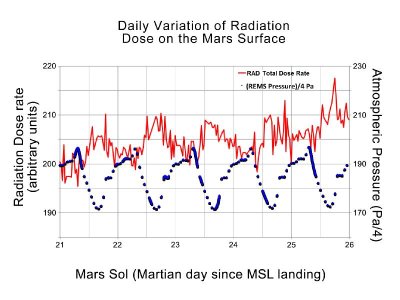Nasa's Curiosity Mars rover has carried out the first ever measurements of radiation on another planet. Its findings suggest that astronauts would be able to live on the surface of Mars for long enough to carry out extended missions.
 |
| Curiosity data showing the relationship between Martian air pressure (blue) and radiation (red) (Image: NASA/JPL-Caltech/SwRI) |
Observations taken by Curiosity's Rover Environmental Monitoring Station (REMS) and Radiation Assessment Detector (RAD) instruments over the rover's first 12 weeks on Mars have revealed a rhythmic link between changes in radiation and daily atmospheric changes.
Seasonal and daily rhythms of air pressure changes detected by REMS were not unexpected, with the seasonal pattern resulting from the release of tons of frozen carbon dioxide from winter ice caps as spring turns to summer in the Martian southern hemisphere. The daily cycle of higher pressure in the morning and lower pressure in the evening results from daytime heating of the atmosphere by the sun, creating a "thermal tide" as the morning works its way westwards around the planet.
Effects of that atmospheric tide show up in data from RAD, which monitors high-energy radiation and observed radiation levels falling and rising by 3-5% per day as atmospheric pressure increases and decreases. RAD principal investigator Don Hassler, of the Southwest Research Institute, explained that the atmosphere provides a level of shielding, so charged-particle radiation is less when the atmosphere is thicker. At present, the radiation readings are reported in arbitrary units. The RAD team is analysing the results and hopes to be able to release precise numbers in early December.
Speaking at a press conference, Hassler explained why the Martian radiation environment is fundamentally different from that of Earth. Unlike Earth, Mars does not have a magnetic field to protect it from high-energy charged particle radiation. In addition, a planet's atmosphere provides shielding against radiation, and the Martian atmosphere is only about 1% the thickness of the Earth's.
Radiation levels at the Martian surface are of interest because they are a life-limiting factor and therefore relevant for the past, present and future habitability of the planet. Overall, shielding effects of the thin Martian atmosphere reduce radiation doses to about half those experienced by Curiosity on its nine-month journey to the planet.
Knowledge about the planet's radiation environment is vital in planning future manned missions to Mars. "Absolutely, astronauts can live in this environment," Hassler confirmed. However, an astronaut's total radiation dose throughout the entire mission, not just on the Martian surface, would need to be considered. With the journey from Earth to Mars taking 8-9 months in both directions, followed by up to 6 months spent on the planet itself and the journey home again, astronauts would need to stay within "career limits" for radiation dose.
Curiosity, which landed in the Gale Crater on Mars in August, is investigating whether areas inside the crater ever have or could provide a habitable environment for microbial life. The mobile laboratory is powered by a plutonium-fuelled nuclear battery which is expected to last through the rover's initially planned two years of operations.
Researched and written
by World Nuclear News




_18570.jpg)
_16159.jpg)
_18938.jpg)
_33584.jpg)





